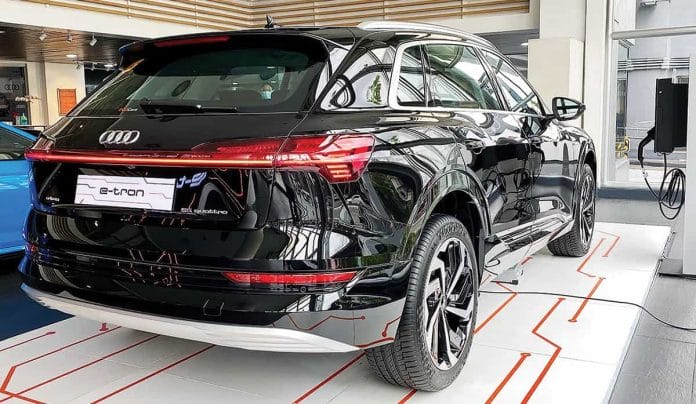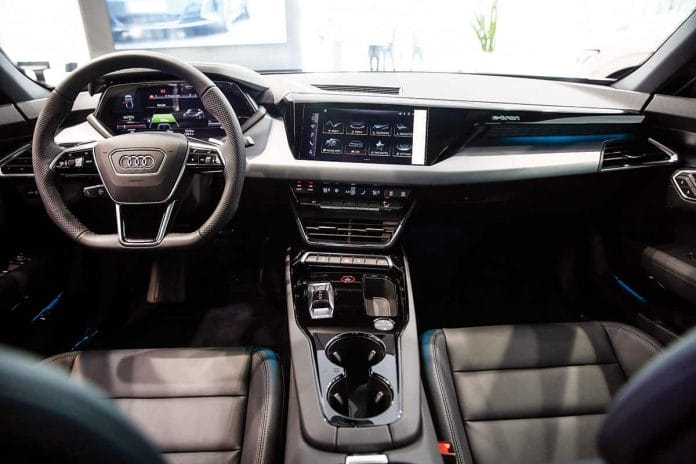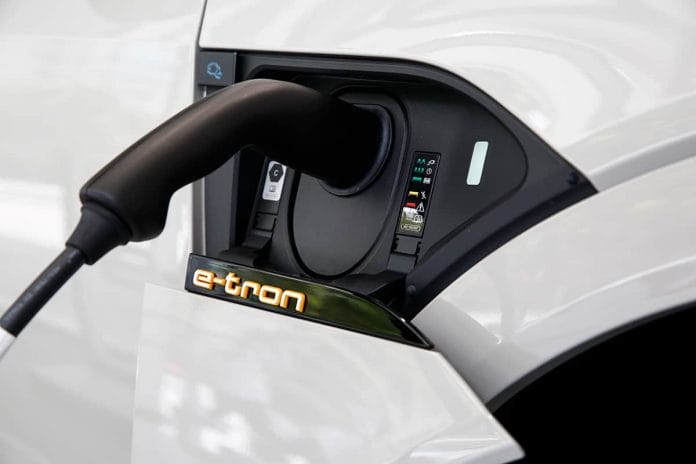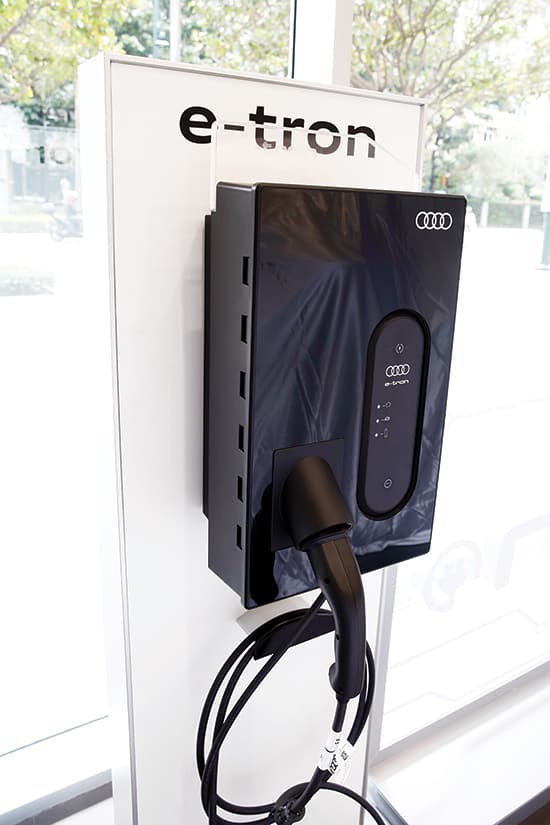It may seem unlikely, but PGA Cars, the country’s exclusive importer and distributor of Audi, Porsche, Bentley, and Lamborghini, now happens to be the automotive company that brings in the most number of fully electric vehicles in the Philippines.
Last year, they brought in the Porsche Taycan, first in all-wheel drove Turbo guise, then followed by the rear-wheel drive variant.
And now, their Audi brand is expanding the group’s EV portfolio with the unveiling of not one, but three fully electric models from Ingolstadt’s much awaited e-tron EV line: the e-tron SUV, the e-tron GT, and the RS e-tron GT.
The e-tron models’ arrival signifies Audi Philippines’ efforts to spearhead the transition towards sustainable, premium electric-powered mobility. All three models are highly suitable for daily driving and combine luxury features, emotive design, and revolutionary technologies with zero-emission, fully electric power plants.


The Audi e-tron SUV Photo by Manny de los Reyes 
Audi Philippines supports the fully electric e-tron range with groundbreaking electromobility initiatives. These include setting up dedicated service facilities for electric vehicles, installing chargers in key destinations, and ensuring home charging solutions that make driving an Audi e-tron as seamless and convenient as using any digital mobile device.
Globally, Audi launched more electric models than internal combusution engine cars in 2021. By 2025, the brand aims to have more than 20 fully electric and 10 partially electric models in its lineup. Starting in 2026, Audi will only launch new models that are fully electric. The company will gradually phase out production of its internal combustion engines by 2033, and from then on all Audi models will be purely electric.
Electrifying drive: Audi e-tron SUV
I got to take a short drive of the e-tron SUV around Greenhills and EDSA. This large SUV offers the cabin space and comfort of the brand’s full-size SUV, the Q8. With high-quality materials and fine workmanship, the Audi e-tron SUV turns electric mobility into a truly luxurious experience.
The e-tron SUV looks, well, electrifying. It bears the brand’s trademark Singleframe grille with a central element finished in platinum gray — identifying the model as fully electric. Horizontal struts at the lower edge of the Matrix LED headlights create the e-tron-specific signature daytime running lights. Black inserts in the sill area visualize the central location of the battery. At the rear, slats in the wide diffuser highlight the absence of exhaust pipes. The e-tron logo on the charging flap stands out in signal orange.
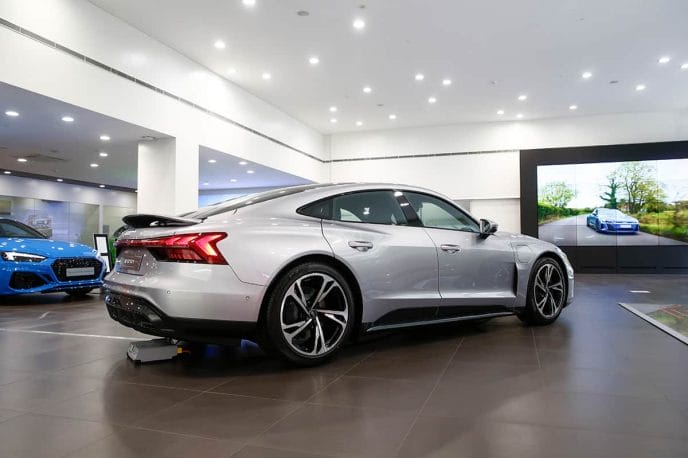
The e-tron SUV’s spacious, airy interior is defined by design that embodies performance, intelligence and lightness. A large arc stretches across from the expansive instrument panel to the sculpted door trims, emphasizing advanced in-car digitization. Floating above the center tunnel is the hand rest with integrated shifter, which the driver operates with thumb and forefinger. Two large MMI touch response displays, replacing nearly every conventional switch and control, are angled toward the driver. Many functions can also be controlled via the natural voice control system. With the standard Audi virtual cockpit, the driver can choose between two views presenting information in high-resolution graphics. Paired with all these are high-quality materials boasting of high craftsmanship.
Performance was equally electrifying, as exmeplified by an impromptu full throttle blast along a deserted Ortigas Avenue. Two electric motors generating (pardon the pun) 408hp and 664Nm allow the vehicle to sprint from 0-100 km/h in 5.7 seconds, with top speed electronically limited to 200 km/h. A new generation electric quattro all-wheel drive provides supreme traction and handling on any terrain and condition. The system continuously varies the distribution of torque between the two axles.
The Audi drive select can vary the characteristics of the e-tron SUV depending on the driving situation, road condition or personal preference. The system also controls the air suspension with adaptive dampers, allowing the driver to choose between comfort and sporty handling. It can also alter the vehicle’s ride height by as much as 76mm.
A key factor in the dynamic performance of the e-tron SUV is the low and central placement of its battery and drive components. The battery is located between the axles, forming a flat, broad block beneath the passenger compartment. This results in a center of gravity similar to that of a sedan, with weight distribution nearly equal front and rear.
Safety is another strength of the e-tron SUV. The model carries a five-star safety rating from the U.S. NHTSA and the Euro NCAP, and is also named a Top Safety Pick+ by the US Insurance Institute for Highway Safety.
The e-tron SUV can cover as much as 484 kilometers on a single charge, thanks to an innovative recuperation system that recovers energy when the vehicle is coasting, and when the brake pedal is pressed. In both cases, the electric motors function as a generator and convert kinetic energy into electricity.
The e-tron SUV, which retails for just under P7 million, can be charged with alternating current (AC) at up to 22kW, with various home charging solutions available. The standard portable charging system can be used with either a household outlet or an industrial three-phase outlet.
Four-door electric supercars: Audi e-tron GT and RS e-tron GT
Demonstrating how exciting electric mobility can be, the Audi e-tron GT and RS e-tron GT four-door coupes combine a unique head-turning design with a powerful drive, dynamic handling, and a long range. The models have long wheelbases with wide tracks, large wheels and flat rooflines. Every detail of their aesthetics arises from efficiency — from the headlights, powerful quattro blisters, wheels, and to the large diffuser at the rear. To reduce weight, their outer skins are made entirely from aluminum. The headlights and rear lights are also characteristic elements of the of the cars’ design.
Active elements manage the Audi e-tron GT and RS e-tron GT’s aerodynamics. Two controllable inlets supply the front brakes and the thermal management with cooling air. The rear spoiler extends to two positions depending on the requirement. Completing the aerodynamics package is the fully paneled underbody, which flows into a broad diffuser.
The interior of the Audi e-tron GT and RS e-tron GT is airy, offering the ambiance of a classic grand tourer. The driver and front passenger sit low, and are separated by a wide center console. The instrument panel is based on Audi’s “monoposto” design, canted toward the driver. The rear compartment can accommodate 405 liters of luggage while the storage compartment beneath the hood provides another 81 liters of space.
Like all Audi models, the e-tron GT and RS e-tron GT are connected extensively. Their displays and controls are operated via the digital Audi virtual cockpit plus, which in turn is controlled through the multifunction steering wheel and the central MMI touch display, as well as by natural language recognition.
The e-tron GT provides ample power and performance. Its two electric motors deliver 530hp and 630Nm, allowing the car to reach 100 km/h from a standstill in only 4.1 seconds. Paired to the electric motors is the electric quattro all-wheel drive system, which ensures maximum stability and traction in any condition, thanks to its ability to constantly vary power distribution between the axles.
The Audi RS e-tron GT, on the other hand, deliver 646hp and 830Nm, making the car the most powerful production model Audi has ever produced. Also equipped with an electric quattro all-wheel drive system, the RS e-tron GT rockets from 0-100 km/h in 3.3 seconds—true supercar performance.
Driven in Comfort mode (activated via Audi drive select), the e-tron GT’s and RS e-tron GT’s electric motors operate in the most energy-conserving way possible. In Dynamic mode, the motor fitted to the rear axle supplies more power than the front, making the cars more suitable to spirited driving. Efficiency mode prioritizes front-wheel drive.
The Audi e-tron GT’s and RS e-tron GT’s electric motors slow the car down most of the time during daily driving, recuperating as much kinetic energy and converting this into electricity. Their conventional brakes are activated only during sudden, heavy stops.
Located on each front fender of the Audi e-tron GT and RS e-tron GT are charging flaps containing charging points for either alternating current (AC) or direct current (DC). Home charging solutions can fully recharge an empty battery overnight. With a fully charged battery, the e-tron GT can travel as much as 500 kilometers while the RS e-tron GT can reach as much as 481 kilometers.
With the e-tron SUV, e-tron GT and RS e-tron GT, Audi is leading the charge (sorry) towards electric mobility in the Philippines.


